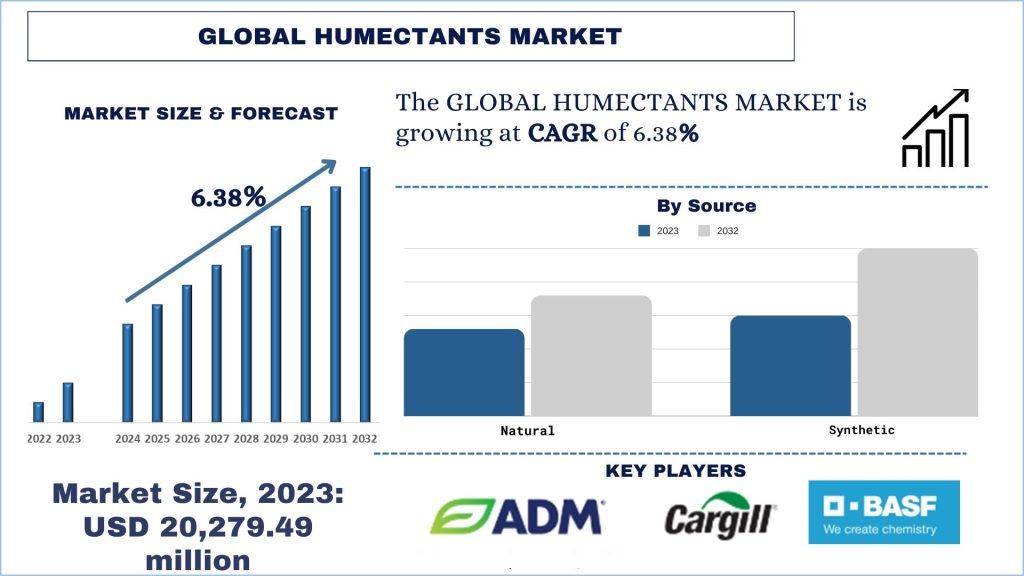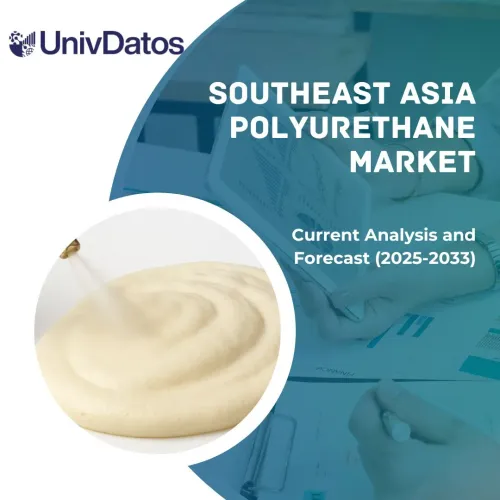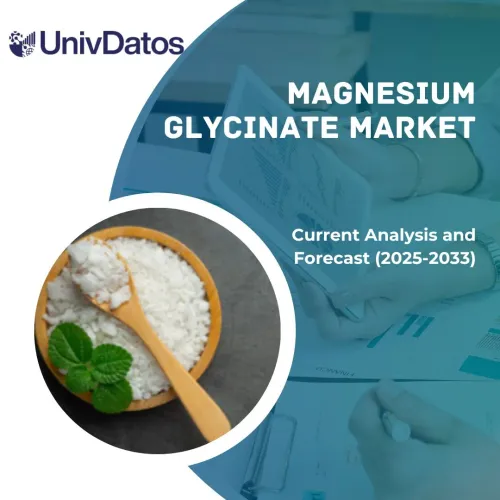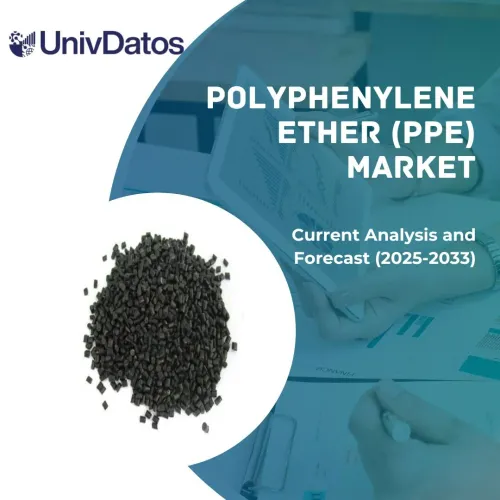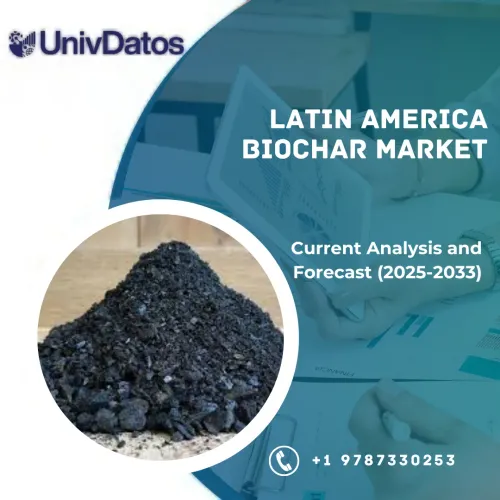- Home
- About Us
- Industry
- Services
- Reading
- Contact Us
Humectants Market: Current Analysis and Forecast (2024-2032)
Emphasis on Source (Natural and Synthetic); Application (Food and Beverages, Personal Care and Cosmetics, Pharmaceuticals, Animal Feed, Agrochemicals, Textiles, and Others); and Region/Country
Humectants Market Size & Forecast
The Humectants Market was valued at USD 20,279.49 million in 2023 and is expected to grow at a robust CAGR of around 6.38% during the forecast period (2024-2032) driven by increasing demand from various industries such as food and beverages, personal care and cosmetics, and pharmaceuticals.
Humectants Market Analysis
The Humectants Market is currently experiencing significant change, fueled by the increasing need for creative and eco-friendly solutions in sectors such as food and beverages, personal care, and pharmaceuticals. This shift is primarily driven by technological advancements, and a rise in consumer consciousness is expected to drive substantial market expansion. The demand for humectants is rising from improving moisture retention and texture in food items to enhancing skin hydration and facilitating drug delivery in personal care and pharmaceutical products. Manufacturers are adapting by introducing cutting-edge innovations reshaping the formulation and application of these versatile ingredients. Moreover, manufacturers are exploring novel delivery systems and formulations to enhance the performance and efficacy of humectants. In November 2022, Ashland Global Holdings announced the launch of a new encapsulated humectant system designed for controlled release and improved moisture retention in various applications. With increasing regulatory scrutiny, companies focus on ensuring compliance and prioritizing product safety. In December 2023, the European Chemicals Agency (ECHA) issued updated guidelines for using certain humectants in consumer products, prompting manufacturers to re-evaluate their formulations and adhere to the new safety standards.
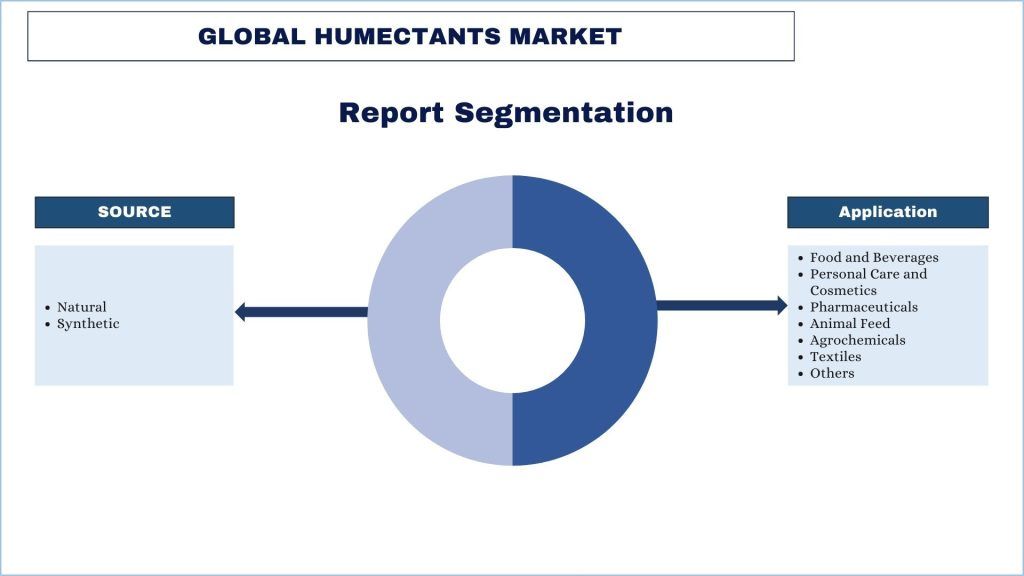
Humectants Market Trends
Increasing Demand for Natural and Sustainable Humectant Ingredients
The increasing demand for natural and sustainable humectant ingredients is a prominent trend in the humectant market, driven by rising consumer awareness, environmental concerns, and regulatory pressure. Consumers are progressively searching for items that lack synthetic chemicals and artificial additives, showing a preference for natural and environmentally friendly alternatives in different sectors such as food and beverages, personal care, and pharmaceuticals. As a result, manufacturers are proactively adjusting their products and allocating resources to research and development to create groundbreaking natural and sustainable humectant solutions. For instance, in 2023, ADM, a Chicago-headquartered nutrition company, launched a direct-to-consumer (D2C) plant-based ingredient line called Knwble Grwn. This range includes flaxseed, hemp seed, quinoa, flax oil, and hemp oil, suitable for various applications, including better-for-you snacks and baked treats. Furthermore, the pharmaceutical industry has also adopted the trend, as companies are now investigating the utilization of natural and plant-derived humectants in drug delivery systems and formulations. This approach presents potential advantages, including enhanced bioavailability and minimized adverse effects.
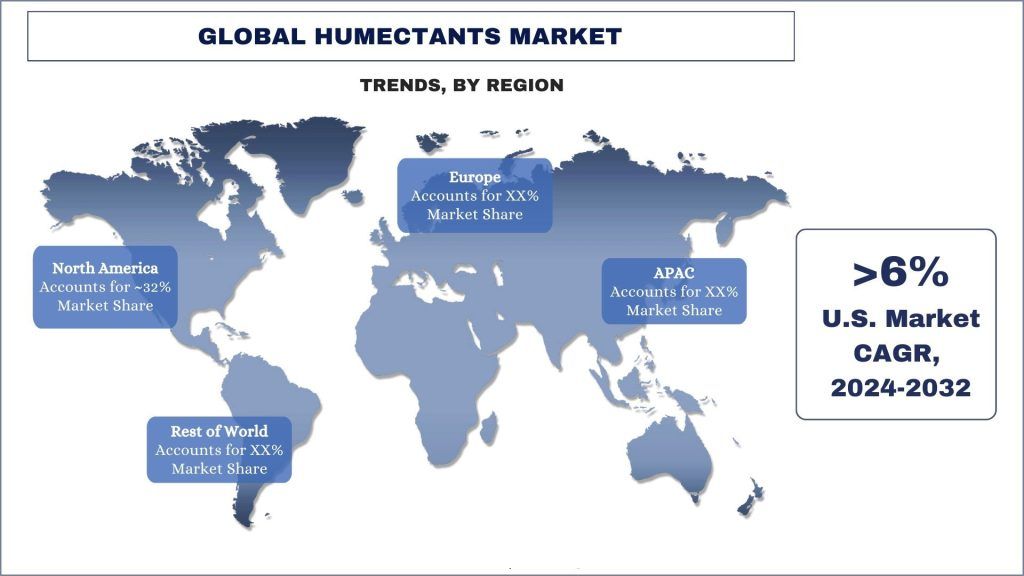
North America Dominated the Humectants Market
The North America humectant market is expected to dominate in the forecast period due to several factors, such as increased demand for clean-label and natural products, growing technological advancements, and the presence of leading food and beverage manufacturers. North America, particularly the United States, is home to some of the world’s largest food and beverage companies, such as PepsiCo, Mondelez International, and The Kraft Heinz Company. These companies are significant consumers of humectants for various applications, driving the demand in the region. Additionally, consumers demand naturally derived humectants such as glycerin, sorbitol, and xylitol products, and manufacturers are reformulating their products to meet this demand. The region’s commitment to technological advancements and innovation has led to the development of advanced humectant formulations and delivery systems. For instance, in 2022, Ingredion, a leading ingredient solutions company based in the US, launched a new line of humectant systems called PRECISA™, designed to provide superior moisture management and shelf-life extension in various food applications.
Humectants Industry Overview
The Humectants Market is competitive and concentrated, with few global and international players. The key players are adopting different growth strategies to enhance their market presence, such as partnerships, agreements, collaborations, new product launches, geographical expansions, and mergers and acquisitions. Some major players operating in the market are ADM, Cargill, Incorporated, SpecialChem, BASF SE, Ashland, Croda International Plc, DuPont, Ingredion, Lonza, and Eastman Chemical Company.
Humectants Market News
- In October 2023, BASF SE invests in the production of emollient specialties at its Düsseldorf site targeted for skin and sun protection products. A new reactor and upgrade of the distillation units enable an expansion of production capacity to meet the increasing demand for these specialty products. The new facilities are scheduled to operate in the third quarter of 2025. Emollients bind and maintain skin moisture and improve the sensory properties of a care product. The need for special emollients for formulations that enable silicone-free skin care and octocrylene-free sun protection continues to increase in Europe.
- In March 2022, Vantage Specialty Chemicals, a leading global supplier of naturally derived specialty ingredients and formulations, acquired JEEN International Corporation and BotanicalsPlus, Inc. JEEN is a leading global provider of naturally derived specialty ingredients and blends for the personal care and cosmetics markets. Their portfolio includes a diverse range of specialized active ingredients, botanical extracts, and complexes serving functional skin and hair care applications. JEEN is known for its innovative leadership in rapid product development and customization to support its global customer base of leading multinationals and emerging indie brands.
Humectants Market Report Coverage
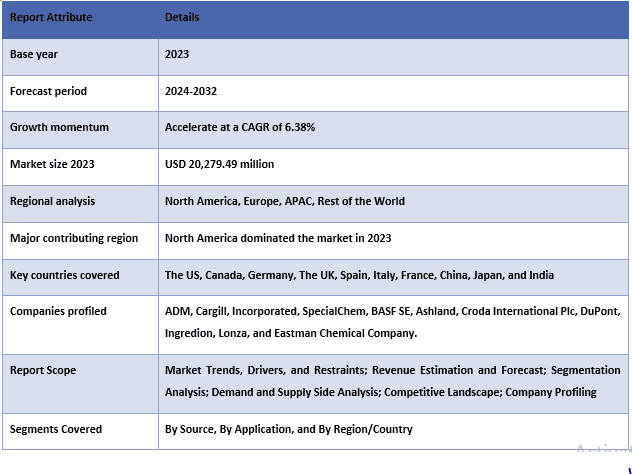 Reasons to buy this report:
Reasons to buy this report:
- The study includes market sizing and forecasting analysis validated by authenticated key industry experts.
- The report presents a quick review of overall industry performance at one glance.
- The report covers an in-depth analysis of prominent industry peers with a primary focus on key business financials, product portfolios, expansion strategies, and recent developments.
- Detailed examination of drivers, restraints, key trends, and opportunities prevailing in the industry.
- The study comprehensively covers the market across different segments.
- Deep dive regional level analysis of the industry.
Customization Options:
The Global Humectants Market can further be customized as per the requirement or any other market segment. Besides this, UMI understands that you may have your own business needs, hence feel free to contact us to get a report that completely suits your requirements.
Table of Content
Research Methodology for the Humectants Market Analysis (2024-2032)
Analyzing the historical market, estimating the current market, and forecasting the future market of the global humectants market were the three major steps undertaken to create and analyze the adoption of humectants in major regions globally. Exhaustive secondary research was conducted to collect the historical market numbers and estimate the current market size. Secondly, to validate these insights, numerous findings and assumptions were taken into consideration. Moreover, exhaustive primary interviews were also conducted, with industry experts across the value chain of the global humectants market. Post assumption and validation of market numbers through primary interviews, we employed a top-down/bottom-up approach to forecasting the complete market size. Thereafter, market breakdown and data triangulation methods were adopted to estimate and analyze the market size of segments and sub-segments of the industry pertains to. Detailed methodology is explained below:
Analysis of Historical Market Size
Step 1: In-Depth Study of Secondary Sources:
Detail secondary study was conducted to obtain the historical market size of the humectants market through company internal sources such as annual reports & financial statements, performance presentations, press releases, etc., and external sources including journals, news & articles, government publications, competitor publications, sector reports, third-party database, and other credible publications.
Step 2: Market Segmentation:
After obtaining the historical market size of the humectants market, we conducted a detailed secondary analysis to gather historical market insights and share for different segments & sub-segments for major regions. Major segments are included in the report source and application. Further country-level analyses were conducted to evaluate the overall adoption of testing models in that region.
Step 3: Factor Analysis:
After acquiring the historical market size of different segments and sub-segments, we conducted a detailed factor analysis to estimate the current market size of the humectants market. Further, we conducted factor analysis using dependent and independent variables such as source and application of the humectants market. A thorough analysis was conducted for demand and supply-side scenarios considering top partnerships, mergers and acquisitions, business expansion, and product launches in the humectants market sector across the globe.
Current Market Size Estimate & Forecast
Current Market Sizing: Based on actionable insights from the above 3 steps, we arrived at the current market size, key players in the global humectants market, and market shares of the segments. All the required percentage shares split, and market breakdowns were determined using the above-mentioned secondary approach and were verified through primary interviews.
Estimation & Forecasting: For market estimation and forecast, weights were assigned to different factors including drivers & trends, restraints, and opportunities available for the stakeholders. After analyzing these factors, relevant forecasting techniques i.e., the top-down/bottom-up approach were applied to arrive at the market forecast for 2032 for different segments and sub-segments across the major markets globally. The research methodology adopted to estimate the market size encompasses:
- The industry’s market size, in terms of revenue (USD) and the adoption rate of the humectants market across the major markets domestically
- All percentage shares, splits, and breakdowns of market segments and sub-segments
- Key players in the global humectants market in terms of products offered. Also, the growth strategies adopted by these players to compete in the fast-growing market.
Market Size and Share Validation
Primary Research: In-depth interviews were conducted with the Key Opinion Leaders (KOLs) including Top Level Executives (CXO/VPs, Sales Head, Marketing Head, Operational Head, Regional Head, Country Head, etc.) across major regions. Primary research findings were then summarized, and statistical analysis was performed to prove the stated hypothesis. Inputs from primary research were consolidated with secondary findings, hence turning information into actionable insights.
Split of Primary Participants in Different Regions
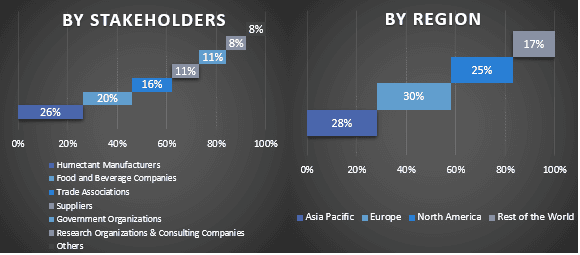
Market Engineering
The data triangulation technique was employed to complete the overall market estimation and to arrive at precise statistical numbers for each segment and sub-segment of the global humectants market. Data was split into several segments & sub-segments post studying various parameters and trends in the areas of the source and application in the global humectants market.
The main objective of the Global Humectants Market Study
The current & future market trends of the global humectants market were pinpointed in the study. Investors can gain strategic insights to base their discretion for investments on the qualitative and quantitative analysis performed in the study. Current and future market trends determined the overall attractiveness of the market at a regional level, providing a platform for the industrial participant to exploit the untapped market to benefit from a first-mover advantage. Other quantitative goals of the studies include:
- Analyze the current and forecast market size of the humectants market in terms of value (USD). Also, analyze the current and forecast market size of different segments and sub-segments.
- Segments in the study include areas of the source and application.
- Define and analyze the regulatory framework for the humectants
- Analyze the value chain involved with the presence of various intermediaries, along with analyzing customer and competitor behaviors of the industry.
- Analyze the current and forecast market size of the humectants market for the major region.
- Major countries of regions studied in the report include Asia Pacific, Europe, North America, and the Rest of the World
- Company profiles of the humectants market and the growth strategies adopted by the market players to sustain the fast-growing market.
- Deep dive regional level analysis of the industry
Frequently Asked Questions FAQs
Q1: What is the current market size and growth potential of the humectants market?
Q2: What are the driving factors for the growth of the humectants market?
Q3: Which segment has the largest humectants market share by Source?
Q4: What are the emerging technologies and trends in the humectants market?
Q5: Which region will dominate the humectants market?
Related Reports
Customers who bought this item also bought

